Category: 116th
Idaho Army National Guard’s best warriors – Barrera, Crockett
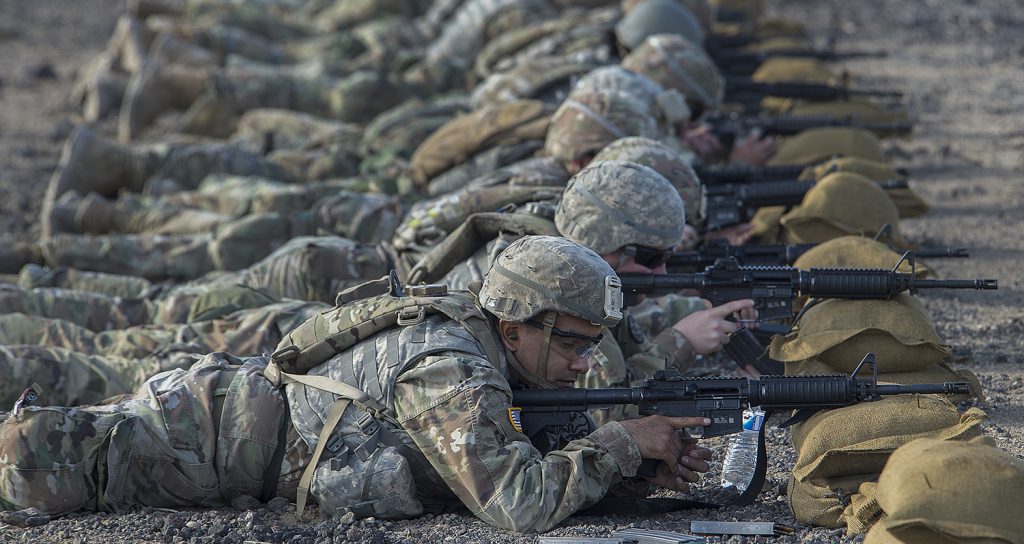
Story by Capt. Robert Taylor
Idaho Army National Guard
After three days of intense competition during the Idaho National Guard’s Best Warrior Competition, Sgt. Roy Barrera Jr. and Spc. Colton Crockett were recognized as the Noncommissioned Officer and Soldier of the Year.
Throughout the competition, four NCOs and 11 Soldiers from across the state competed in the event held at Gowen Field and the Orchard Combat Training Center Sep. 5-7.
“This competition is about the warrior spirit,” said Brig. Gen. Farin Schwartz, commander, Idaho Army National Guard.
Barrera Jr. and Crockett both serve in the 116th Cavalry Brigade Combat Team. Barrera Jr. is in the brigade’s headquarters company and Crockett serves in the 2nd Battalion, 116th Cavalry Regiment.
Sgt. Andrew Henson, also from 2-116 CAV REG, finished second in the NCO category. Sgt. Jordan Hudson and Cpl. Juan Campos also competed to be the state’s top NCO.
Spc. Alex Amour finished as the runner up for the Soldier category. Spc. Jonathon Ames, Pfc. Rodney Farichild, Spc. Jaslyn Greco, Prf. Connor Hensley, Spc. Isaac Morado, Pfc. Adam Nichols, Pfc. Nathan Rands, Pfc. Benjamin Rudolph and Spc. Dakota Woodwick also competed in the completion.
“These Soldiers are a great representative of the Idaho Army National Guard,” Schwartz said. “Their high level of physical fitness and mental fitness separates them from their peers.”
Competitors were tested on numerous Army Warrior Tasks, including their ability to disassemble and reassemble multiple weapons; land navigation at day and night; ruck marching; shooting; combatives; first aid and the Army’s new Army Combat Fitness Test. Competitors were stressed physically with little sleep to push them to their limits.
Intel Center of Excellence deputy general visits National Training Center
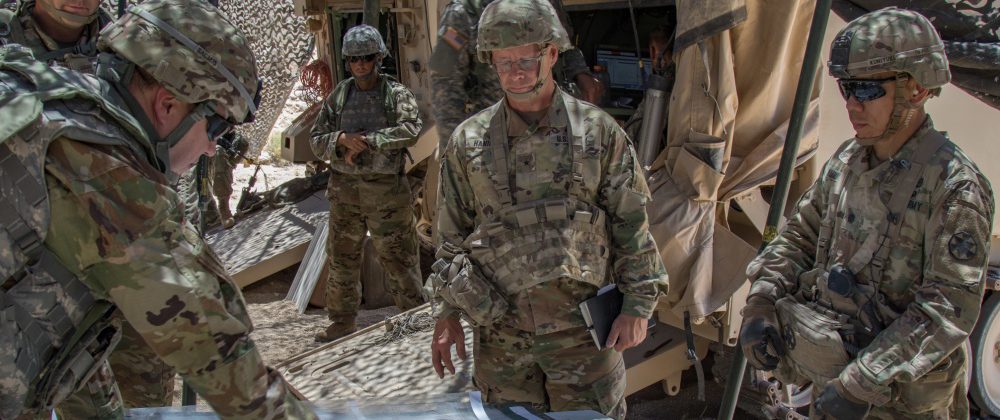
FORT IRWIN, CA, UNITED STATES
06.05.2019
Story by Capt. Robert Taylor
Brig. Gen. Michael K. Hanifan, deputy commanding general, United States Army Intelligence Center of Excellence, visited with 116th Cavalry Brigade Combat Team’s intelligence officers and sections June 3-4, 2019, at the National Training Center in Fort Irwin, California, to see firsthand how the Army’s school for professional training of military intelligence prepares Soldiers to operate in a combat training center environment.
“I saw some sharp leader who knew what they were doing,” he said. “We need to equip them with the correct equipment and training.”
Hanifan said the school, located at Fort Huachuca, Arizona, has recently made three chances to its training requirements to provide Soldiers with effective and relevant training to be successful in their units. Those changes include placing an emphasis on getting away from creating only digital products and enhancing analog skills; shifting away from training on counterinsurgency in favor of decisive-engagement operations; and offering more training in a field environment outside of a classroom
“The changes in our focus has been very affective,” Hanifan said. “We’re headed in the right direction.”
Hanifan saw the effect of those changes on full display as the 116th CBCT’s intel sections worked to track the enemy on the battlefield using a combination of digital systems and analog products in the most realistic decisive-engagement field training environment the Army provides.
Throughout the simulated battle against opposing forces provided by the U.S. Army’s 11th Armored Cavalry Regiment, brigade and battalion intelligence personnel work together to provide commanders at all levels with a common operating picture of friendly and enemy forces’ locations and dispositions.
Information flows up and down echelons across the battlefield to answer commanders’ priority intelligence requirements and to detect, find and destroy enemy assets using available assets, including non-lethal targeting options.
Information collected is analyzed and fed through the brigade’s planning process and current operation cell. Information collected on the battlefield is imperative for commanders and their staffs.
“As elements move forward, we provide the commander with the best enemy picture possible so he can leverage the combat power he has available to make the best decisions possible,” said Capt. William Miller, 2nd Battalion, 116th Cavalry Regiment intelligence officer.
Hanifan, who also serves as the assistant adjutant general, Nevada Army National Guard, believes the National Training Center is the hardest intelligence battle Soldiers will fight, specifically designed to prepare Soldiers for operations in a combat zone. The training provides intel analyst the chance to test their skills against an actual force.
“It’s very realistic,” Spc. Anna Tinseth said. “It’s not notional. What you see on the map is what you’re going to see on the battlefield.”
Tinseth, a 35F intelligence analyst assigned to the Oregon Army National Guard’s 3-116th Cavalry Regiment, said the hands-on experience she is receiving during the 15-day field training exercise is increasing her understanding of her role in a battalion headquarters.
“I’m starting to understand how effective intelligence can be,” she said. “We can better prepare our line units to know what they are going to face on the battlefield.”
The 116th CBCT, one of the National Guard’s five armored brigade combat teams, is completing a National Training Center rotation at Fort Irwin, May 24 – June 20. NTC provides the brigade with the opportunity to train against a near-peer opposing force, challenging Soldiers’ tactical proficiencies and their technical expertise. More than 4,000 Soldiers, including Soldiers from Army National Guard units in 13 states, are participating in the exercise.
Kansas Army National Guard engineers support 116th CBCT
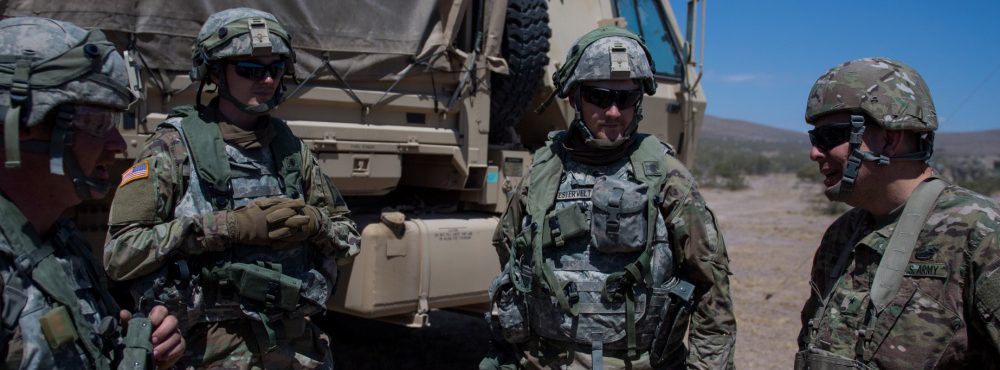
FORT IRWIN, CA, UNITED STATES
06.01.2019
Story by Capt. Robert Taylor
Two companies from the Kansas Army National Guard’s 891st Engineer Battalion are currently completing a rotation at the National Training Center in Fort Irwin, California, to prepare to conduct future real-world missions during unit deployments.
The 242nd Engineer Company, based in Coffeyville, and the 772nd Engineer Mobility Augmentation Company, based in Pittsburgh, are providing engineer support to the Army National Guard’s 116th Cavalry Brigade Combat Team May 24 – June 20.
“Supporting another National Guard unit is what the Guard is all about,” said Brig. Gen. Anthony V. Mohatt, commander, Kansas Army National Guard. “Being able to support another Guard unit is something we’re proud to do as the Kansas Army National Guard and I’m glad we had the opportunity to do so this year.”
The 116th CBCT is one of the National Guard’s five armored brigade combat teams and is comprised of more than 3,000 Soldiers, including roughly 1,800 Idaho Army National Guard Soldiers and 1,200 Soldiers serving in battalions from the Montana, Nevada and Oregon Army National Guard. During the rotation, the brigade is supplemented by units from nine additional Army National Guard states and three U.S. Army Reserve units for a total force of more than 4,000 Soldiers.
The 772nd MAC enhances the brigade’s 116th Brigade Engineer Battalion’s mobility assets with its assault, breaching and counter-mobility equipment, including Assault Breacher Vehicles, the Volcano Mine System and M58 Mine Clearing Line Charges. Combat engineers also provide increased obstacle placement capabilities.
The 242nd Engineer Company provides the brigade with heavy construction equipment to dig anti-vehicle ditches, vehicle fighting positions and other survivability positions. Two of the company’s platoons are currently attached to the 116th BEB’s organic engineer companies.
The rotation provides both companies with the opportunity to execute its wartime missions in a tactical environment in the most realistic training environment the Army can provide.
“The training improves our lethality,” said Capt. Kevin Hubbard, 242nd Engineer Company commander. “We’re ready to deploy anywhere in the world.”
Throughout the rotation the 116th CBCT, headquartered in Boise, Idaho, will engage the U.S. Army’s 11th Armored Cavalry Regiment in force-on-force simulated combat operations against a near-pear adversary.
“Coming to a NTC rotation allows for individual Soldier development, leader development and increased unit readiness to be ready for our federal mission when called upon.”
For Spc. Frankie Moore, a 772nd MAC 12B combat engineer, NTC also offers him the chance to spend additional time with his battle buddies.
“I love hanging out with the guys,” Moore said. “The comradery, trust and friendship I have with Soldiers is something I don’t have in the civilian world. I miss it from deployments.”
Command Sgt. Maj. Randolph takes cares care of Soldiers
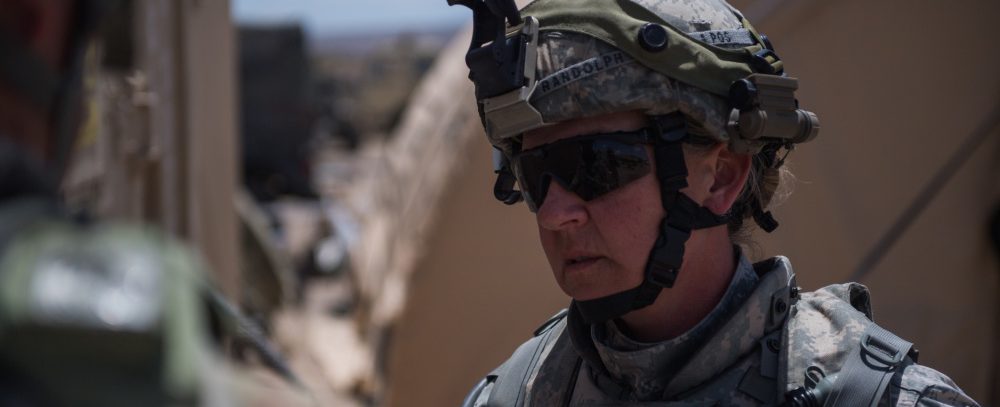
FORT IRWIN, CA, UNITED STATES
06.02.2019
Story by Capt. Robert Taylor
Command Sgt. Maj. Alice Randolph knows she’s the 116th Cavalry Brigade Combat Team’s senior female noncommissioned officer, but it’s not something she spends a lot of time thinking about.
“I identify as a command sergeant major,” Randolph said.
As the 145th Brigade Support Battalion’s command sergeant major, Randolph’s primary mission is the taking care of the battalion’s 300 enlisted Soldiers.
“Taking care of Soldiers means teaching them, training them and mentoring them,” she said. “The best part of the job is watching Soldiers grow throughout their careers.”
Randolph enlisted into an U.S. Army Reserve unit when she was 17 and four years later transferred into Idaho Army National Guard.
“It was the best decision of my life,” she said. “The Army has been really good to me.”
Randolph has served as a 68W combat medic throughout her career. She’s spent the majority of her career in the 145th BSB, including time as a platoon sergeant and company commander before she was appointed to the battalion’s top enlisted spot in May 2017.
“I love 145th BSB Soldiers,” she said. “They really are the best group of Soldiers I’ve worked with. With most of the unit located in Northern Idaho, we have to be close knit.”
The 145th BSB provides logistic support to the 116th Cavalry Brigade Combat Team. Its distribution company, A Company, and maintenance company, B Company, are both located in Post Falls. The unit’s brigade support medical company is located in Boise. The battalion’s headquarters is located in Lewiston, along with detachments from B and C companies. Forward support companies are attached to each of the brigade’s seven battalions to provide direct support.
As the battalion’s senior enlisted member, she serves as a member of the commander’s personal staff and provides him technical and tactical advice on the planning, training, preparation and execution of all unit missions. As the only female sergeant major in the battalion, she said it’s not uncommon for her to be the only female in senior brigade leader meetings.
“I’ve gotten used to being include in ‘gentlemen,’” she said, while adding she’s never felt she’s been treated differently throughout her career because she is a female Soldier.
The battalion is currently supporting the 116th Cavalry Brigade Combat Team’s National Training Center rotation at Fort Irwin, California, which offers the unit the opportunity to sustain one of the National Guard’s five armored brigade combat teams across an astute environment roughly the size of Rhode Island. The U.S. Army’s 11th Armored Calvary Regiment provides the brigade with a near-peer opposing force, challenging Soldiers in the unit’s tactical proficiencies as well as its technical expertise.
“No matter how hard things get, the Soldiers make it fun and get the job done,” she said.
Like father like sons, Bundy brothers serve together
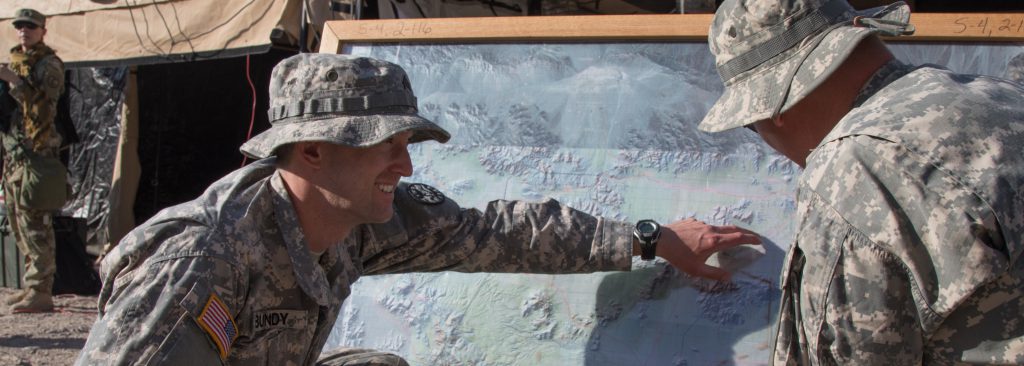
FORT IRWIN, CA, UNITED STATES
06.01.2019
Story by Capt. Robert Taylor
Idaho Army National Guard Soldiers 2nd Lt. Zane Bundy and his big brother Sgt. Nathan Bundy take after their father, Mountain Home city councilman Matt Bundy, in a number of ways.
All three work for the Mountain Home School District. Matt and Nathan both teach at Mountain Home High School and Zane is a substitute teacher who hopes to have his own classroom someday. In addition, all three either have, or are currently serving in the military.
Matt retired from the United States Air Force. Nathan and Zane both serve in the 116th Cavalry Brigade Combat Team’s 2nd Battalion, 116th Cavalry Regiment, headquarted in Caldwell. For the next couple weeks, both are participating in the brigade’s National Training Center at Fort Irwin, California.
“I was raised on the idea of serving my country,” said Nathan, who enlisted into the Idaho Army National Guard in 2012 as a 35F intelligence analyst.
Nathan is the intelligence section’s senior noncommissioned officer. His team’s job is to help analyze intel Soldiers in the combined arms battalion collect to help his battalion commander make good decisions on the battlefield.
It’s a position that’s vastly different than Zane’s job, who leads a platoon in Idaho’s only infantry company from his Bradley Fighting Vehicle.
“Serving together gives us a new dynamic in our relationship,” Nate said. “It’s a new common ground and a shared experience, but we’re also on different sides of the Army as an enlisted intel Soldier and an infantry officer.”
Zane joined the Idaho Army National Guard in January 2017 and later earned his commission in November 2017.
“I saw how great of an opportunity Nate had to be in the Guard so I thought I would follow,” Zane said.
At his commissioning ceremony, Nathan was the first to salute his younger brother of four years.
“I was really proud of him when he commissioned,” Nathan said.
Zane said he doesn’t get to see much of his brother during unit operations but that it’s always good to see him when the two cross paths. Both agreed that serving in the National Guard provides them with experiences they don’t get to have in the classroom as teachers.
“I enjoy both jobs,” Nate said. “Being able to serve part-time is a great experience.”
The 116th Cavalry Brigade Combat Team is completing a month-long rotation at the National Training Center to build unit readiness and increase Solider proficiency in their wartime missions. The unit will train against a near-peer opposing force provided by the Army’s 11th Armored Cavalry Regiment. More than 4,000 Soldiers, from more than 30 Army National Guard states, are participating in the exercise.
116th CBCT arrives at the National Training Center
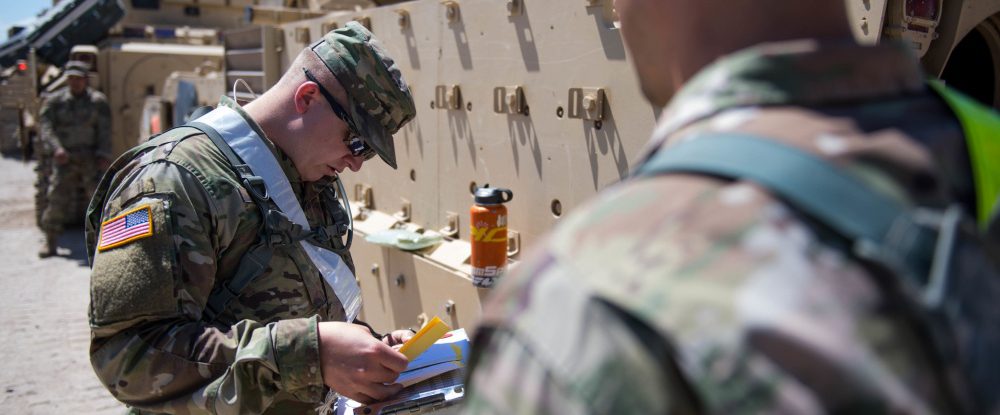
FORT IRWIN, CA, UNITED STATES
05.28.2019
Story by Capt. Robert Taylor
Soldiers from the Idaho Army National Guard’s 116th Cavalry Brigade Combat Team have mobilized to the National Training Center at Fort Irwin, California, to participate in a large-scale exercise. This deployment is the state’s largest since 2015.
“The National Training Center provides some of the most realistic training the Army has to offer,” said 116th CBCT commander Col. Scott Sheridan. “This gives us the opportunity to exercise our warfighting functions in a way we can’t anywhere else. 116th CBCT Soldiers have trained extensively over the past four years and are ready to demonstrate their tactical and technical proficiencies in an austere environment.”
The 116th CBCT is comprised of more than 3,000 Soldiers, with roughly 1,800 Soldiers from 137 Idaho communities and 1,200 Soldiers serving in battalions from the Montana, Nevada and Oregon Army National Guards.
Through force-on-force simulated combat operations, Soldiers will have the rare opportunity to train against a near-peer force, provided by the U.S. Army’s 11th Armored Cavalry Regiment. Soldiers will also live-fire major weapon platforms, to include the M1A1/A2 Abrams Main Battle Tank, the M2A3/M3 Bradley Fighting Vehicle, the M109A6 Paladin and the M58 Mine Clearing Line Charge.
The NTC is one of the Army’s largest combat training centers and is roughly the size of Rhode Island. Its desolate climate and varied terrain will test the brigade’s ability to sustain itself in a large and austere environment.
More than 1,000 Soldiers in Army National Guard units from eight additional states and Puerto Rico, along with three U.S. Army Reserve units, will join forces with the 116th during the rotation to complete the brigade’s combat power. In addition, the Idaho Air National Guard’s 124th Fighter Wing will provide close air support using A-10 Thunderbolt II aircraft during the 116th CBCT’s simulated combat operations.
“Everybody in this task force is a member of the 116th CBCT regardless of the patch on your shoulder,” Sheridan told senior battalion leaders Sunday during a unit movement rehearsal.
The task force comprises an additional 56 National Guard companies, platoons or sections, to include the Arizona Army National Guard’s 158th Combat Sustainment Support Battalion and the California Army National Guard’s 1st Assault Helicopter Battalion of the 140th Aviation Regiment.
The 116th CBCT last attended the NTC in 2015. The training rotation is the brigade’s capstone training event in its four-year training cycle before the unit is available to complete a real-world mission in 2020.
Idaho Army National Guard, 116th CBCT Soldiers conduct signal gunnery

BOISE, ID, UNITED STATES
02.19.2019
Courtesy Story
Idaho Army National Guard
The 116th Cavalry Brigade Combat Team signal Soldiers conducted signal gunnery Feb. 5-10 on Gowen Field and in the Orchard Combat Training Center to train signal Soldiers on their communication platforms in a challenging environment.
“Information is a weapon we wield,” said Chief Warrant Officer 3 Jerred Edgar, the brigade’s network defense chief. “Our communication platforms bring the messages that put rounds on target.”
Approximately 100 signal Soldiers from each of the 116th CBCT’s seven battalions and the Idaho Army National Guard’s 1-183rd Aviation Battalion who hold six signal military occupational specialties participated in the exercise. The training audience focused on junior leader and crew proficiencies.
The training was planned and executed by Idaho Army National Guard Soldiers assigned to the brigade’s communications section to accommodate the brigade’s training schedule prior to its upcoming rotation at the National Training Center.
The exercise was an expansion of last year’s signal gunnery, the first in the brigade’s history. Edgar developed the concept of “signal gunnery” over two years ago after not being able to find any doctrine regarding crew-level training in the Army to mirror the kind of training line units are familiar with.
This year saw the addition of the 1-183rd Aviation Battalion and incorporated battalion signal officers. Four officers were assigned crews in a manner comparable to their organic unit’s structure. They had to plan, track, maneuver and synchronize their crews through their communication platforms.
“We typically are consolidated at one location,” said Capt. Kenneth McNamara, battalion signal officer. “It is different having them far away. It creates a greater challenge for command and control.”
This year’s training was conducted during extreme cold weather, which Edgar said provided an excellent training environment for developing basic Soldier skills. Crew leaders learned how to operate in cold weather, which included rotating Soldiers on tasks to ensure their Soldiers stay healthy and their mission objectives are achieved.
“It’s very difficult, especially with the wind gusts and cold temperatures,” said Spc. Christopher Payne, a joint network node operator. “Things just take more time because of cold weather gear. Sometimes we just sucked it up and removed our gloves to get the job done.”
The five-day training event gave Soldiers the chance to train on their assigned equipment and practice setting it up quickly. During the two-day field exercise, crews jumped four times, including twice at night.
“It’s good to see the growth and development from last year, I definitely feel more confident with my equipment,” Payne said.
The brigade will participate in a National Training Center rotation in May and June to prepare for a possible follow on a real-world mission in 2020. NTC, located at Fort Irwin, California, is one of the Army’s largest training centers and allows the brigade to conduct combat operations against a simulated enemy force.
 Official Government Website
Official Government Website